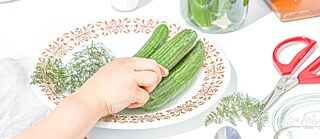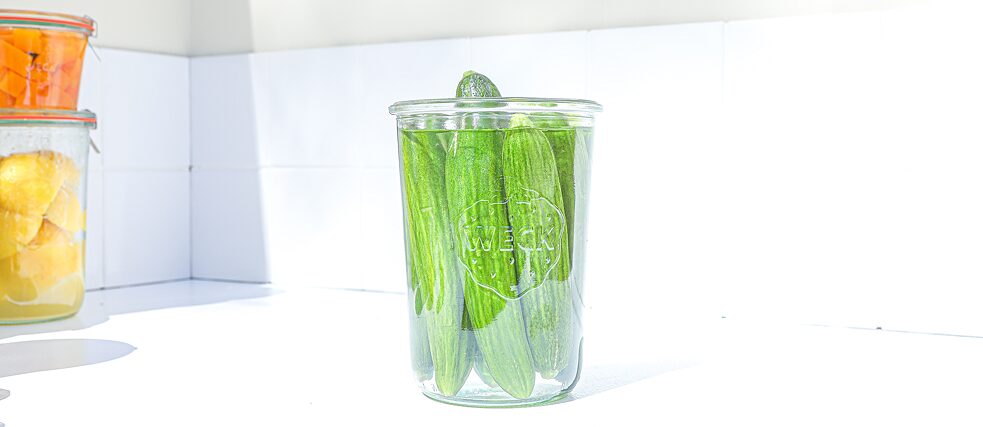Endless Varieties
Pickling Cucumbers
Some might say pickles are typically German, but — small and large alike — these crunchy green pickled veggies also come in Russian, French, and Polish varieties. In our household, we prefer the Spreewald preparation. Pickled cucumbers are widely available in all shapes and sizes. Nevertheless, I felt the need to make them myself. A long road lay ahead of me!
How to find the perfect pickle recipe?
Everyone has their own personal preference when it comes to jarred cucumbers. Some prefer them small and very crunchy; others think it’s okay if the skin is a little soft. The important thing is that they’re juicy! Another question is how much vinegar you want to taste. Do you want your mouth to pucker up or do you prefer it a little sweeter? Do you prefer fermented pickles? Some people prefer lots of spices, while minimalists like to stick to mustard seed and juniper.Our family likes it tart with a sweet note. They like their cucumbers crisp, not too big, and well seasoned!
I’ve experimented a lot, and I have accumulated quite a few recipes for pickled cucumbers on my blog over time. I started with cucumber infusion, which you can buy ready-made. It was a good start, but somehow it felt pointless to use ready-made ingredients when you wanted to make something yourself. Instead, I began making my own cucumber infusion. Each time, the wait was long, only to discover when we opened the jar that it wasn’t the flavor we were looking for. I kept testing recipes, mixing ingredients, and finally came up with a recipe we all liked that we’ve been using for years now. Every year, we look forward to when the plants in the garden are laden with cucumbers, and a big canning day is coming up. Because then, “pickle season” officially begins!
When you’ve been tinkering with a recipe for so long and thought you’d never get it down perfectly, you appreciate the result that much more. It’s a wonderful feeling to repeat it year after year, and I dream of passing it on as a family recipe to the next generation.
Ingredients
- 1,300 grams (2.8 pounds) of cucumbers, preferably smaller ones
- 225 grams (0.5 pounds) of shallots, either two smaller ones or one very large one
- 5 large garlic cloves
- 1 bunch of fresh dill
- 1 bunch of dill flowers
- 500 milliliters (2 cups) of white wine vinegar
- 500 milliliters (2 cups) of water
- 190 grams (0.75 cups) of sugar
- 50 grams (1.76 ounces) of salt
- 2 teaspoons of yellow mustard seeds
- 0.5 teaspoons of brown mustard seeds
- 5 bay leaves
- 10 grains of coriander seeds
- 10 black peppercorns
- 5 cardamom pods
Directions
Scrub the cucumbers thoroughly with a vegetable brush, dry them, and arrange them tightly in clean, preferably sterilized, canning jars. Peel and coarsely chop the garlic and shallots, and distribute them evenly among the jars.Pluck the dill flowers from the stems, and distribute them among the jars. Likewise, place a bay leaf in each jar. Chop the dill.
In a saucepan, bring the vinegar, salt, sugar, water, mustard seeds, pepper, dill, coriander, and cardamom pods to a boil. Remove the mixture from the heat, and pour it into the jars while still hot.
Close the jars tightly with screw caps or with canning lids, rubber rings, and clamps. Then, in a canning machine or in a pot filled with water, process the jars for 35 minutes at 90°C/194°F. Then, allow them to cool at room temperature. If using canning jars, do not remove the metal clamps until the jars have cooled completely.
The jars should now be stored on the pantry shelf for some time. The cucumbers taste best when they have steeped for at least six weeks.







